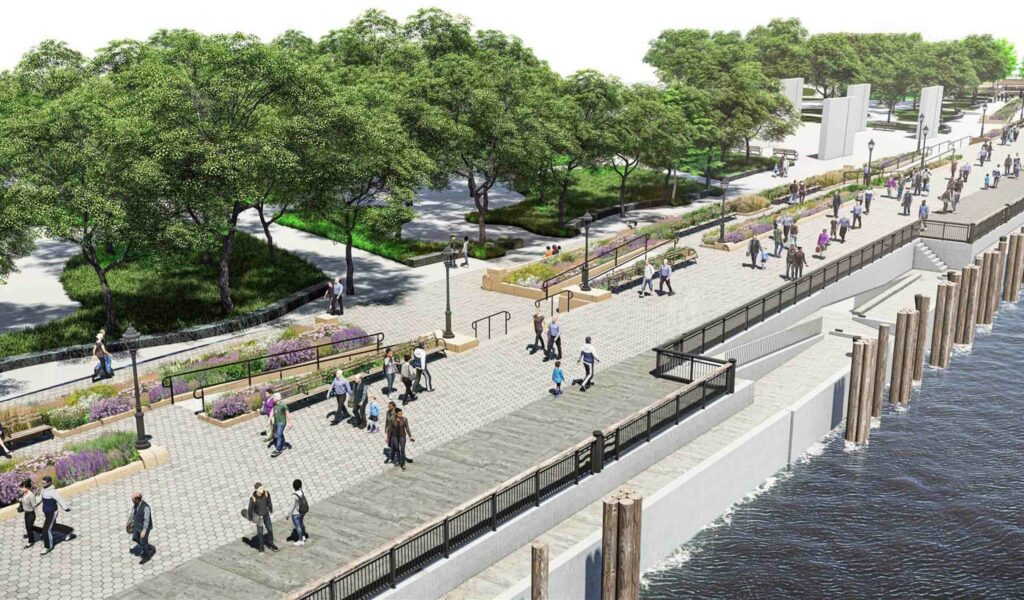
The Battery Coastal Resilience Project has been awarded the Envision Platinum Award by the Institute for Sustainable Infrastructure (ISI). The project forms part of a wider initiative to bolster Lower Manhattan’s coastline against rising sea levels and increasingly severe storms.
Led by the New York City Economic Development Corporation (NYCEDC) on behalf of the City’s Department of Parks & Recreation and the Mayors of Climate and Environmental Justice, the project will see the existing, deteriorating wharf structure rebuilt at a higher elevation. This will provide crucial protection against rising sea levels while seamlessly integrating with the beloved waterfront park at the southern tip of Manhattan.
“The Lower Manhattan Coastal Resiliency (LMCR) project sets the standard for future projects of this kind, marrying coastal protection with an ambitious sustainability agenda,” said Andrew Kimball, president and chief executive officer of NYCEDC. “We are proud of LMCR and the teams involved for receiving the Envision Platinum Award, all in an effort to create a cleaner, greener New York City.”
The Battery is a vibrant waterfront space, boasting extensive gardens, public art installations, and cultural landmarks. It also serves as the departure point for ferries carrying thousands of visitors to the Statue of Liberty each year. The project aims to ensure the continued resilience of this vital area for the next 80 years, promoting sustainable and robust infrastructure throughout Lower Manhattan.
Sustainability considerations were paramount throughout the project’s development, with the Envision framework used to monitor and improve its environmental impact. Key areas of focus included reducing embodied carbon, effectively managing stormwater runoff, and minimising landfill waste. This resulted in a series of innovative strategies, including the reuse of existing materials from the site, the use of locally sourced and low-carbon materials in construction, and the exploration of alternative transportation options to reduce emissions and pollutants.
A standout feature of the wharf’s design is its multi-level slip system. This innovative approach provides universal access for vessels with varying freeboard heights, taking into account the projected rise in sea levels between now and 2100. This adaptable design ensures flexibility in the face of an uncertain future, while safeguarding cherished views of the harbour, preserving architectural details, and maintaining the character of the existing park.
Material reuse and waste management were also key considerations during the design phase. The project incorporates significant quantities of granite, metals, and wood salvaged from the existing site, with a prioritised hierarchy for removing any remaining materials that emphasises reuse and recycling, thereby minimising landfill waste. Plantings have been carefully selected to thrive in the harsh coastal environment, withstanding increased salt tolerance and the anticipated rise in urban heat. These plantings will maintain the colourful and vibrant perennial displays that characterise the wider park throughout the seasons.
“Given the Battery’s rich history and cultural significance, a holistic approach to sustainable and resilient design was essential for this project,” said Greg Sprich, Principal at Stantec, the global design leader for the project. “The design team rose to the challenge, delivering a project that not only safeguards Lower Manhattan’s coastline but also serves as a blueprint for minimising waste and embodied carbon in future infrastructure projects.”
The project directly addresses the imminent threat of rising sea levels, while restoring the wharf to a safe and usable condition. It will also play a vital role in preserving the Battery’s iconic and historic character for future generations. Construction is planned in two phases to minimise disruption to park users and ferry services to Liberty and Ellis Islands, with project completion targeted for 2026.
“With sea levels rising and storms growing stronger and more frequent, it is vital that we invest in protecting our city from the effects of climate change. Our innovative plans for the Battery are helping to ensure that the Lower Manhattan waterfront is well-prepared for the 21st century’s extreme weather and rising tides, without sacrificing New Yorkers’ access to this historic and beloved greenspace. The challenges of climate change affect cities across the country and around the world, and I’m so proud that New York City is setting an example with this creative and exciting approach, which rebuilds our critical infrastructure while minimizing waste and utilizing local, recycled materials.”
— Sue Donoghue, commissioner at New York City Department of Parks and Recreation
“As New York City advances coastal resilience projects in a dense urban environment, it is essential that we minimize harmful emissions from our construction and waste sent to landfills. With NYCEDC’s Envision Platinum Award, the city has met and exceeded our Clean Construction Accelerator goal of reducing embodied emissions in infrastructure projects by 50 percent.”
— Elijah Hutchinson, executive director at New York City Mayor’s Office of Climate & Environmental Justice
“The Battery protected Manhattan against threats from the sea when its shoreline forts deterred foreign navies. Today, the Battery is called to serve again—to defend the city we love from the sea itself. The Battery Conservancy is proud to work with New York’s leadership to ensure that this storied public space will continue to attract and comfort water-gazers and garden-lovers.”
— Warrie Price, president and founder at The Battery Conservancy
“Resilient and sustainable environments are the result of collective effort and vision, which is at the core of the Lower Manhattan Coastal Resiliency – Battery Project. This award recognizes the extensive planning, design, and coordination efforts made by the team to showcase sustainable resilience infrastructure and green construction practices.”
— Ethan Smith, project manager/Envision lead – construction at Hunter Roberts Construction Group
“As communities invest in infrastructure projects, it’s crucial to incorporate sustainable and resilient features that account for the projected impacts of climate change. This project is an outstanding demonstration of how a project team can successfully work with a variety of community stakeholders to assess infrastructure vulnerability and use the Envision framework to plan for resiliency.”
— Kristi Wamstad, verification director at ISI
Swanwick House, 22 Towcester Road, Old Stratford, Milton Keynes, MK19 6AQ, UK
© 2025 Project Management Global. All rights reserved | Privacy Policy